
Costa del sol bjuder på många dina utflyktsmål.
Läs om mina förslag på vackra bergsturer.
Välkommen till min webbsida som handlar om trivsamma platser i Europa, utflykter i Andalusien och sköna promenader i Stockholm.
Klicka på det som intresserar dig!
Trevlig läsning
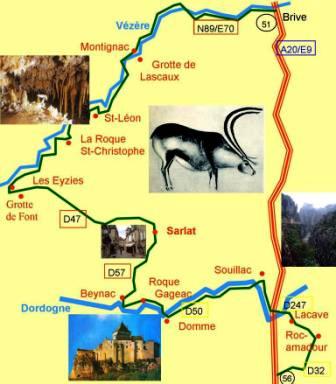
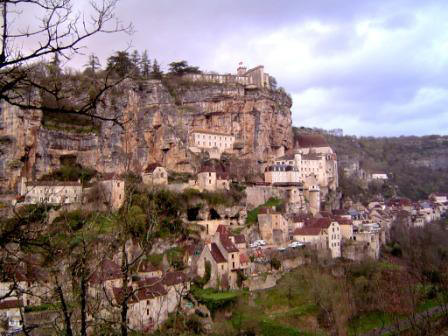
Rocamadour -where the houses balance on rockledges
A FASCINATING CAVE LANDSCAPE
A 20, E9 between exits 51 and 56
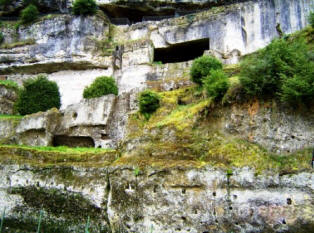
Right in the centre of the south of France lies the fertile province Périgord, embedded among luxuriant oak- and chestnut woods. The climate is mild and the land is overflowing with wine, milk and honey, a veritable Cockaigne and a good dwelling place for mankind since time immemorial. It is still a popular holiday destination where especially Englishmen, and naturally Frenchmen too, have managed to find their way and even settled down permanently.
But for its rivers, this could be almost any other rural landscape on this latitude. Here, though, a rich system of rivers and brooks, many of them originating in the nearby Massif Central, have dug deep into the mountain and left behind an incredible, fairytale landscape. This is due to the porous limestone. High cliff walls frame the rivers and hundreds of caves with passages up to a kilometre long have delved through the mountains.
A LITTLE PIECE OF HEAVEN ON EARTH
In these very parts were found the first traces of art and culture in Europe, and it is easy to see why. Here we have all the necessary conditions: a fertile soil, deep forests with all kinds of wild animals, rivers teeming with fish, strategic defence outposts on high cliff tops, and, last but not least, all those caves, offering free accommodation to its inhabitants.
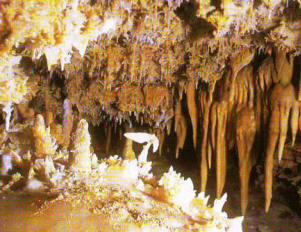
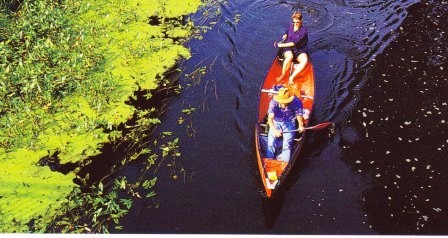
THE VÉZÈRE VALLEY
Perhaps the finest examples of prehistoric cave art are the paintings in Grotte de Lascaux in Montignac by the Vézère river. These caves were discovered in 1940 by a dog who wandered off into a labyrinthine cavern, followed by two little boys, who, when they got back home, told a remarkable story of colourful pictures of bulls, deer, bison and horses. The cave became a tourist magnet but unfortunately had to be closed when it was increasingly clear that the exhaled air from all the tourists was ruining the paintings. However, the new, artificial cave with well-made reconstructions of the paintings is well worth a visit.
The Vézère river winds its leisurely way down in the valley, inviting you to come on a peaceful canoe trip. Gliding along on the water you are very close to nature, where the cliffs positively surround you one moment, only to give way to a meadow in bloom, a green, leafy grove or an idyllic little village the next. It is a bit like travelling through a historical gallery where you can give your imagination free rein. We paddle under a bridge in the medieval village of St. Léon, passing by the beautiful 16th century castle Château de Losse and gaze in awe at the imposing, 80 metre high and one kilometre long Roque St-Christophe, where people have sought refuge for tens of thousands of years. During the middle ages the rock gradually took on the character of fortified town with people living in the many holes and caverns, of which there are a good one hundred.
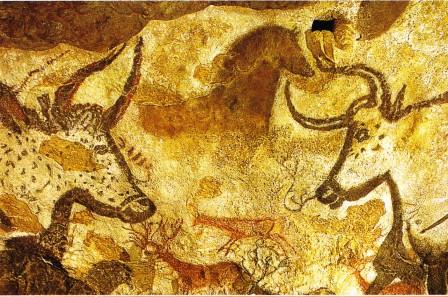
LA CAPITALE DE LA PRÉHISTOIRE
If you really want to see an authentic cave with paintings, there is one in Les Eyzies, La Grotte de Font-de-Gaume. Here are beautiful, gaudy depictions, ca 15,000 years old, of bison, deer and horses. But it can be rather difficult to get tickets, especially during peak season, so please make sure you book well in advance! Here are also several other kinds of caves, a. o. La Grotte du Grand-Roc, which offers fantastic stalactite and stalagmite formations in splendid colours. In front of the Cro Magnon cave, up on a cliff-top, stands an awe-inspiring statue of Prehistoric Man, marking the place of discovery of 30,000- years-old human remains, from which we are the direct descendants. All this and more besides has led to the town acquiring the epithet “The Capital of Prehistory”, and quite right, too. Apart from its interesting prehistoric museum, housed in a medieval castle in the town, nowhere else in the world is such a huge concentration of caves to be found in such a limited area.
SARLAT – LA CAPITALE DU PÉRIGORD NOIR
The “real” capital of the area, however, is Sarlat, and what a capital that is! The collection of grand old buildings held here in one small area is without compare in the rest of Europe! In this little town it is a sheer delight just to wander around as you please. Keep a look-out for the beautiful gothic and renaissance houses, built in the local yellow stone, and savour the medieval atmosphere in this very vivid town with its many nice restaurants, where they serve the specialities of the district: goose-liver, truffles, roast goose and walnut cakes. Why not try the red Cahors wine and the walnut liqueur as well!
THE DORDOGNE VALLEY
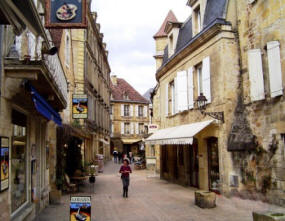
The Dordogne river is also framed by high cliffs along some parts of it and people still live in villages which cling on to the limestone walls, and are still making use of the cavities in the mountain.The sweet little villages Beynac and Roque-Gageac, sitting pretty by the river, are excellent examples of this. High above the village Beynac sits a fairy tale castle which stirs the imagination, and on the other side of the river rises the fortress Castelnaud. After that the castles follow one another in quick succession on either side of the river. They were once part of a defence system, which also included many of the so-called fortified towns. A good example is the village of Domme which crouches high up on a cliff. The fortified towns were built by both Englishmen and Frenchmen in the 13th century to encourage settlement in certain desolate areas which they either wanted to conquer or were having to defend.
During the Hundred Year Wars in the 14th and 15th centuries these fortified towns did good service and were strengthened even further. Protected by a steep hill to the north and a solid town wall on its south side, Domme must have been practically impregnable. Today it is an idyllic village with a fabulous panoramic view over the Dordogne river, meandering its way between green poplar trees through vast grassland. Scattered
farms and villages, limestone cliffs and forests stretch far away into the distance. The village itself is like any typical, fortified town with a grid system of streets which merge into the “main square”. In Domme this bears the name of Place de la Halle and harbours its own little secret: directly under the square is a lift down into the nether regions and a cave with suggestive limestone pillars and lakes as smooth as glass.
Before travelling on to the last stop of our tour we pay a visit to the town Souillac, which proudly presents its domed, 12th century cathedral. We also pass the castle in Lacave and an adventure park where you get to see life-size prehistoric animals and can observe life in a village from long-ago days.
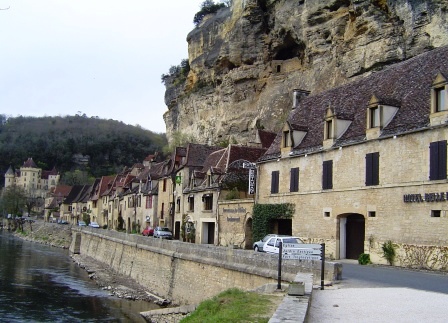
ROCAMADOUR (from roc amator, meaning admirer of cliffs)
I have saved the real jewel in the crown till last. For who could fail to be impressed by the much-loved cliff of Amadour? Amadour was a hermit from early Christendom whose remains were discovered here in the 12th century. This gave rise to a number of miracles which in turn caused hordes of pilgrims to flock to the place. Rocamadour is a three-star tourist attraction clinging on to a steep limestone cliff. At the bottom end is the medieval village. A bit higher up is poised Place St-Amadour with its seven churches and chapels. The most famous one of these is Chapelle Miraculeuse with its black Madonna, a popular pilgrim destination ever since the middle ages. The pilgrims had to crawl on their hands and knees all the way up a long and steep staircase. A narrow road then leads the rest of the way up to the castle, situated on the highest top right on the edge of the ravine.
Nowadays we would take the car up to the castle or the lift down into the ravine, visiting all the interesting sights in comfort: the medieval gates, Grand-Rue with its fine old houses, the great basilica of St-Sauveur, the chapels, the grave of Amadour, the stations of the cross and the castle. Do make a point of catching one last glimpse of Rocamadour in your rear-view mirror on leaving! You will be rewarded with an unforgettable image, making you want to come back here again. Rocamadour is worth more than one visit. It has a lot of cosy little houses to rent for shorter or longer periods. It is a favourite haunt of the Brits who tend to buy holiday homes here - might this be a case of history repeating itself? In this region there is much more to discover, so maybe it could become a favourite haunt for us Swedes as well?
Cave dwellings, inhabited already 20000 years ago
Stalagtite and stalagmite caves in Samothrace
The Bull Hall,
Grotte de Lascaux
The Vézére river invites you to come on a canoe trip
Quite flows the Dordogne past Roque Gageac
Sarlat - a true "wild strawberry patch" with beautiful houses to admire on a walk through cosy pedestrian streets